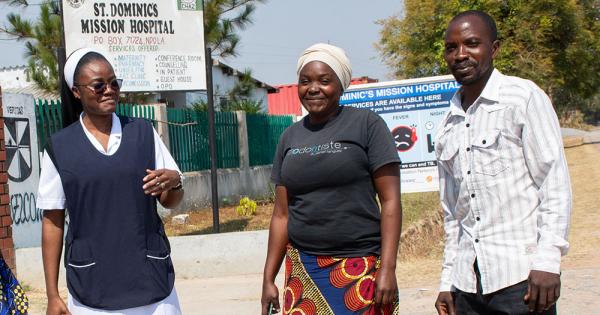Association between air pollution and type II diabetes in Italy from clinical data and population-weighted exposure at the municipality level – Nature

Executive Summary
This report details a study investigating the association between ambient particulate matter (PM2.5 and PM10) pollution and Type 2 Diabetes (T2DM) in Italian municipalities from 2013 to 2021. The research directly addresses key targets within the Sustainable Development Goals (SDGs), particularly SDG 3 (Good Health and Well-being) and SDG 11 (Sustainable Cities and Communities). By leveraging unique, non-self-reported clinical data from the Italian Association of Diabetologists (AMD) and population-weighted exposure (PWE) data from the Italian Institute for Environmental Protection and Research (ISPRA), the study provides critical evidence on the environmental determinants of non-communicable diseases. Key findings indicate a statistically significant positive association between the proportion of PM2.5 within total PM10 and both the incidence and prevalence of T2DM at the municipal level. While T2DM incidence rates showed a decreasing trend over the study period, prevalence proportions increased, highlighting a growing public health burden. These results underscore the urgent need for integrated policies that address air quality to protect public health, reduce health inequalities (SDG 10), and promote sustainable urban environments.
Introduction: Aligning Health and Environmental Research with Sustainable Development Goals
The 2030 Agenda for Sustainable Development provides a critical framework for understanding the interconnected challenges of public health and environmental degradation. This study is situated at the nexus of several SDGs, examining the link between air pollution and T2DM in Italy—a country facing significant challenges in both areas.
- SDG 3 (Good Health and Well-being): The study directly contributes to Target 3.4, which aims to reduce premature mortality from non-communicable diseases (NCDs) like diabetes, and Target 3.9, which focuses on reducing illnesses and deaths from hazardous chemicals and air pollution.
- SDG 11 (Sustainable Cities and Communities): By analyzing pollution at the municipal level, this research addresses Target 11.6, which calls for reducing the adverse per capita environmental impact of cities, including by paying special attention to air quality.
- SDG 10 (Reduced Inequalities): The investigation reveals geographical disparities in both pollution exposure and disease burden, particularly the North-South dualism, thereby highlighting health inequalities that must be addressed to achieve sustainable development.
This report is the first in Italy to use longitudinal, clinical-level data for T2DM and high-resolution, population-weighted exposure data for air pollutants across the entire nation. This approach overcomes the limitations of self-reported data and provides a granular view of the environmental health risks, offering a robust evidence base for policy-making aligned with the SDGs.
Methodology for Assessing Environmental Health Impacts
The research methodology was designed to provide a comprehensive analysis of the association between air pollution and T2DM, reflecting a multi-stakeholder collaboration in line with SDG 17 (Partnerships for the Goals).
Data Acquisition and Integration
- T2DM Clinical Data: Longitudinal outpatient data from 2013-2021 were provided by the Italian Diabetologists Association (AMD). This dataset is the only national source based on clinical diagnoses rather than self-reporting, ensuring high accuracy for T2DM prevalence and incidence calculations at the municipality level.
- Air Pollution Exposure Data: Annual population-weighted exposure (PWE) data for PM2.5 and PM10 were sourced from the Italian Institute for Environmental Protection and Research (ISPRA). These data were generated using a Bayesian hierarchical model, providing high-resolution (1 km²) daily concentration maps for all Italian municipalities.
Analytical Framework
A multi-faceted statistical approach was employed to analyze the data and assess the relationship between variables.
- Regression Models: Poisson mixed-effects models and linear mixed-effects models were used to quantify the association between T2DM (prevalence and incidence) and environmental factors (PM10 and the PM2.5/PM10 ratio, or pwratio), while controlling for demographic variables like year, age, and sex. Random effects were included for municipality and region to account for the data’s hierarchical structure.
- Machine Learning: Non-parametric regression trees (CARTs) were used to explore complex, non-linear relationships and identify the most influential variables in explaining the variability of T2DM rates.
Key Findings: The Intersection of Air Quality and Public Health
Environmental Exposure Analysis
Analysis of ISPRA data confirmed significant geographical disparities in air pollution, directly impacting progress toward SDG 11.6. The Po Valley and other industrialized zones were identified as hotspots with consistently high PWE levels for both PM10 and PM2.5, exceeding EU and WHO guidelines. This highlights areas where targeted interventions are most needed to improve air quality and create healthier communities.
Health Outcome Analysis: T2DM Trends
The AMD dataset revealed diverging trends in the T2DM burden, a key indicator for SDG 3.4.
- Incidence Rates: A statistically significant decreasing trend was observed over time (coefficient = -0.07961, p
- Prevalence Proportions: A statistically significant increasing trend was observed over time (coefficient = 0.01749, p
Men consistently showed higher incidence and prevalence rates than women, and rates were highest in the southern regions of Italy.
Statistical Association between Pollution and T2DM
The mixed-effects models established a clear link between air quality and T2DM, providing evidence for the environmental risk factors targeted by SDG 3.9.
- The ratio of PM2.5 to PM10 (pwratio) was the most significant environmental predictor. Increases in this ratio were significantly and positively associated with both T2DM incidence rates (coefficient = 0.52304, p p
- This indicates that for the same level of total particulate matter (PM10), a higher share of the finer, more hazardous PM2.5 particles poses a greater risk for developing T2DM.
- After adjusting for other factors, PM10 exposure was not significantly associated with incidence rates but showed a significant negative association with prevalence proportions, a counterintuitive finding possibly related to increased mortality in highly polluted areas.
Discussion: Implications for SDG Targets
The findings of this study reinforce the critical link between environmental health and the achievement of the SDGs. The demonstrated association between PM2.5 exposure and T2DM confirms that air pollution is a significant barrier to achieving SDG 3.4 (reducing NCDs). Municipalities with poor air quality, particularly those with a high fraction of PM2.5, face a dual burden of environmental degradation and adverse health outcomes, hindering progress on SDG 11.
The geographical disparities observed, with industrial northern regions showing high pollution and southern regions showing high T2DM rates, suggest a complex interplay of factors that contributes to health inequalities, a core concern of SDG 10. The results align with global research and provide specific, actionable evidence for the Italian context, emphasizing that policies to improve air quality are also public health policies.
Conclusion and Policy Recommendations for Sustainable Development
This research provides robust evidence that exposure to air pollution, particularly the PM2.5 component, is significantly associated with higher rates of T2DM in Italy. This connection underscores the indivisible nature of the 2030 Agenda, where environmental action is fundamental to public health and equity.
To accelerate progress toward the SDGs, the following policy recommendations are proposed:
- Adopt a ‘One Health’ Approach: Policymakers must break down silos between health, environment, and economic sectors, in line with SDG 17. Environmental policies, such as emissions regulations and environmental taxation, should be evaluated through a health lens, explicitly including their impact on NCDs like diabetes.
- Strengthen Environmental Regulations and Monitoring: Efforts to reduce particulate matter pollution must be intensified, with a specific focus on PM2.5. This is essential for making cities and human settlements inclusive, safe, resilient, and sustainable (SDG 11).
- Promote Health Equity: Redistributive policies and strengthened healthcare services are needed for populations in areas with high environmental exposure. This includes providing subsidized access to screening and treatment for diabetes to mitigate the disproportionate burden on vulnerable groups and reduce inequalities (SDG 10).
- Integrate Health in All Policies: Health impact assessments should be mandatory in the cost-benefit analysis of infrastructure, urban planning, and industrial projects to ensure that development pathways support, rather than undermine, public well-being (SDG 3).
By addressing the environmental determinants of health, Italy can mitigate the costly burden of T2DM and advance its commitment to a sustainable and healthy future for all its citizens.
Analysis of Sustainable Development Goals (SDGs) in the Article
1. Which SDGs are addressed or connected to the issues highlighted in the article?
The article on the association between air pollution and Type 2 Diabetes (T2DM) in Italy addresses several interconnected Sustainable Development Goals. The analysis reveals a primary focus on health and environmental quality, with significant implications for urban sustainability, inequality, and collaborative action.
- SDG 3: Good Health and Well-being: This is the most central SDG to the article. The entire study is dedicated to investigating a major health issue—the rising prevalence and incidence of a non-communicable disease (T2DM)—and its link to environmental health risks. The article explicitly states its aim is “to verify the possible association between T2DM and exposure to PM2.5 and PM10.”
- SDG 11: Sustainable Cities and Communities: The research is framed at the “municipality level,” directly addressing urban environmental quality. The article highlights that air pollution is a critical issue in Italian urban and industrialized areas, such as the Po Valley. It discusses how factors like urbanization contribute to the problem, linking environmental management in human settlements to public health outcomes.
- SDG 10: Reduced Inequalities: The article touches upon inequality in several ways. It points out the “historical development gap characterized by a North-South dualism” in Italy, which affects industrialization, population density, and consequently, pollution levels and health outcomes. Furthermore, the conclusion notes that the burden of disease can “affect vulnerable populations disproportionately, such as low-income groups, people living in densely populated urban areas…thereby reinforcing health and economic inequalities.”
- SDG 17: Partnerships for the Goals: The study itself is a clear example of a multi-stakeholder partnership. The research was made possible through “exclusive research collaboration agreements” between academic researchers, the Italian Association of Diabetologists (AMD), and the Italian Institute for Environmental Protection and Research (ISPRA). This collaboration was essential for accessing the unique clinical and environmental datasets needed for the analysis.
2. What specific targets under those SDGs can be identified based on the article’s content?
Based on the identified SDGs, several specific targets are relevant to the article’s scope and findings.
-
Under SDG 3 (Good Health and Well-being):
- Target 3.4: By 2030, reduce by one third premature mortality from non-communicable diseases through prevention and treatment and promote mental health and well-being. The article directly addresses this target by focusing on T2DM, a major non-communicable disease. It analyzes its incidence and prevalence, providing evidence that can inform prevention strategies related to environmental factors. The conclusion emphasizes the need to understand the “environmental determinants of T2DM” to better prevent the disease.
- Target 3.9: By 2030, substantially reduce the number of deaths and illnesses from hazardous chemicals and air, water and soil pollution and contamination. This target is at the core of the study. The research hypothesis and findings are centered on quantifying the association between “illnesses” (T2DM) and “air pollution” (specifically PM2.5 and PM10), directly aligning with the goal of reducing the health burden from environmental contamination.
-
Under SDG 11 (Sustainable Cities and Communities):
- Target 11.6: By 2030, reduce the adverse per capita environmental impact of cities, including by paying special attention to air quality and municipal and other waste management. The study’s focus on air quality (PM2.5 and PM10) at the “municipality level” is a direct engagement with this target. The use of a “population-weighted exposure (PWE) indicator” is a method for assessing the per capita environmental impact of air pollution in cities and communities across Italy.
-
Under SDG 10 (Reduced Inequalities):
- Target 10.3: Ensure equal opportunity and reduce inequalities of outcome, including by eliminating discriminatory laws, policies and practices and promoting appropriate legislation, policies and action in this regard. The article’s policy implications section suggests “redistributive and compensatory policies for population groups exposed to greater environmental and health risks,” which directly relates to reducing inequalities of outcome in health.
-
Under SDG 17 (Partnerships for the Goals):
- Target 17.17: Encourage and promote effective public, public-private and civil society partnerships, building on the experience and resourcing strategies of partnerships. The methodology of the study is a testament to this target. The authors state that the data “were provided to us through exclusive research collaboration agreements” involving public bodies (ISPRA), civil society/professional associations (AMD), and academia, demonstrating an effective partnership to generate new knowledge.
3. Are there any indicators mentioned or implied in the article that can be used to measure progress towards the identified targets?
The article mentions and uses several quantitative metrics that align with or serve as proxies for official SDG indicators.
-
For Target 3.4 (Reduce mortality from NCDs):
- Implied Indicator (related to 3.4.1): The article provides detailed statistics on T2DM incidence rates and prevalence proportions. For instance, it reports that “T2DM prevalence proportions were significantly positively associated with time” and provides specific rates per 100,000 patients by geographical area. These are direct measures of the disease burden, which is a key component of monitoring progress on NCDs.
-
For Target 3.9 (Reduce illnesses from pollution):
- Implied Indicator (related to 3.9.1): The study’s core statistical findings, such as the regression coefficients showing the association between PM exposure and T2DM rates (e.g., “increases in the ratio of PM2.5 to PM10…were significantly positively associated with increases in T2DM incidence rates”), serve as a measure of the morbidity burden attributable to ambient air pollution.
-
For Target 11.6 (Reduce environmental impact of cities):
- Direct Match for Indicator 11.6.2: The article explicitly uses the “annual mean levels of fine particulate matter (e.g. PM2.5 and PM10) in cities (population weighted).” The methodology states that the study uses “annual population-weighted exposure (PWE)” data for PM2.5 and PM10 for 8100 Italian municipalities, which is precisely what indicator 11.6.2 measures.
-
For Target 10.3 (Reduce inequalities of outcome):
- Implied Indicator: The article provides data on the disparity in health outcomes between different geographical regions. It notes a “North-South dualism” and reports that “Incidence is consistently higher for men and tends to decrease from the South to the North.” Comparing these rates across regions serves as an indicator of health inequality.
-
For Target 17.17 (Promote partnerships):
- Implied Indicator: The existence of the research collaboration itself, as described in the acknowledgements and methods sections (“We would like to express our gratitude to the Italian Diabetologist Association (AMD) for their exclusive collaboration research agreement…”), serves as a qualitative indicator of a successful multi-stakeholder partnership for sustainable development research.
4. Table of SDGs, Targets, and Indicators
| SDGs | Targets | Indicators (Mentioned or Implied in the Article) |
|---|---|---|
| SDG 3: Good Health and Well-being |
3.4: Reduce premature mortality from non-communicable diseases (NCDs).
3.9: Reduce deaths and illnesses from air pollution. |
– T2DM incidence rates (e.g., “average incidence rate…equal to 26.56 for women and 33.73 for men” in the South in 2013). – T2DM prevalence proportions (e.g., “average prevalence proportion…of 132.9 for women and 155.5 for men” in the South in 2013). – Morbidity burden associated with air pollution (statistical association between PM exposure and T2DM rates). |
| SDG 11: Sustainable Cities and Communities | 11.6: Reduce the adverse per capita environmental impact of cities, focusing on air quality. | – Annual mean levels of PM2.5 and PM10 at the municipal level, population-weighted (explicitly mentioned as the “population-weighted exposure (PWE) indicator”). |
| SDG 10: Reduced Inequalities | 10.3: Ensure equal opportunity and reduce inequalities of outcome. |
– Disparities in T2DM incidence and prevalence across different geographical areas (North-South dualism). – Disproportionate health burden on vulnerable populations living in high-pollution areas. |
| SDG 17: Partnerships for the Goals | 17.17: Encourage and promote effective public, public-private and civil society partnerships. | – The existence of the research collaboration between academia (Sapienza University), a public institution (ISPRA), and a civil society organization (AMD) to produce the study. |
Source: nature.com

What is Your Reaction?
 Like
0
Like
0
 Dislike
0
Dislike
0
 Love
0
Love
0
 Funny
0
Funny
0
 Angry
0
Angry
0
 Sad
0
Sad
0
 Wow
0
Wow
0















































































